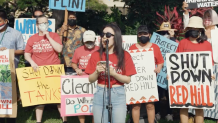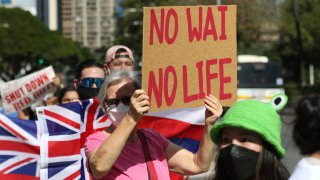On the surface, Hawaii’s waters are perfectly calm. Waves lap at the surface, children waddle about. While many flock to the islands as an idyllic getaway, Hawaiian residents cannot escape the water contamination crisis the U.S. Navy has caused — threatening the drinking water supply of over 400,000 residents.
Sam Ikehara viscerally remembers what it was like hearing that hundreds of families drinking from the Navy’s water sources in Honolulu were consuming water with contaminants up to 350 times above levels considered safe, according to the Hawaii Department of Health.

“There are no words to express that kind of grief and devastation,” she told NBCLX in an email.
Red Hill and Leaking Petroleum
Growing up in Hawaii, the activist was surrounded by members of grassroots organization O’ahu Water Protectors as they worked around the clock, warning the Navy about the irreparable harm the Red Hill Bulk Fuel Storage Facility, which stores fuel for use at Joint Base Pearl Harbor-Hickam, could cause.

For over 80 years, the Navy stored over 100 million gallons of fuel in Kapūkakī, also known as Red Hill, located only 100 feet above O’ahu’s key source of drinking water. The tanks leaked petroleum into a drinking water well, and those consuming the contaminated water experienced symptoms like nausea and rashes, the Associated Press reported.
Hawaii’s pollution is part of a broader pattern of the U.S. military contaminating water, especially in areas with predominantly residents of color.
AFFF and “Forever Chemicals”
On military bases, one source of drinking water contamination is the drills that require explosions or fires, which are usually put out with a foam called aqueous film forming foam, or AFFF. Invented by the Navy, the foam is made with high concentrations of a group of chemicals called PFAS, which then percolate into groundwater that is often a source of drinking water, according to Elsie Sunderland, Ph.D., professor at Harvard University’s department of environmental health. PFAS don't break down in the environment, according to the CDC, so once they're in waterways, they can stick around for years, garnering the nickname “forever chemicals” as a result.
The Department of Defense identified 687 military sites that could be contaminated with the toxic PFAS compounds as of June 2021. Watersheds with at least one military base with a fire training area are 2.7 times more likely to have detectable PFAS in its drinking water utilities, according to Xindi Hu, Sc.D., an activist and former researcher at Harvard University’s School of Engineering and Applied Sciences.
“Urgent measures need to be put in place to protect the public health,” Hu said via email.
Fighting Back
Throughout her research, Hu found that many low-income communities, especially communities of color, rely on private wells for drinking water. Hu said private wells are more likely to be contaminated when in close proximity to military sites. What’s more, regulations and monitoring delineated by the Safe Drinking Water Act don't apply to private wells, which, due to limited resources, are not routinely tested, Hu said.
Eliminating drinking water contamination usually comes with a large financial burden for communities. Sunderland explained that these communities usually can’t afford large-scale cleanups because the necessary technology is expensive. She’s seen affected communities go to court, fighting for reparations from institutions like the military for years on end, to no avail.
In 2021, Hu was the lead researcher behind building accessible predictive models that make it easy to monitor which private wells have a higher risk of being contaminated by PFAS. “My work strives to put high-quality drinking water quality data back in the hands of the ones who need it the most,” Hu added.
The water contamination situation devastated Hiya Shah, 12th grade student at Amador Valley High School in Northern California and winner of the Environmental Protection Agency President’s Environmental Youth Award. Shah lives in Pleasanton, where PFAS pollution in the city’s water has been potentially linked to the nearby Lawrence Livermore National Library — home to military training facilities, Kathleen Yurchak, director of operations and water utilities for the city of Pleasanton, told NBCLX.
When Shah’s high school found lead in its drinking water, she was determined to make a difference. Without access to her school’s lab facilities due to the COVID-19 pandemic, Shah struggled to get started, but it didn’t stop her from developing her app.
“I knew that I wanted to do my part to help to secure clean water in my community and eventually nationwide,” she said via email. “My mission is to make real-time water quality information accessible to anyone, anytime, anywhere to help civilians and municipalities proactively and collectively combat clean water inequality.”
With her background in computer science and water conservation advocacy, Shah set in motion Maji — a mobile app that disseminates real-time estimates of a user’s household water quality. According to Shah, the app implements local water testing data and machine learning so users can access transparent comparisons of water quality within a community and find recommendations for filtration systems. In addition to the Maji app, Shah also designed a sustainable, energy-efficient PFAS water filter.
What’s Next?
Despite advocacy groups’ and residents’ protests against military bases, Ikehara pointed out movements and outrage have largely fallen on deaf ears. She explained there is a great deal of emotional and physical labor that has gone into orchestrating often frustrating protests against the Navy and elected officials.
Still, Ikehara has been proud to watch her community come together to organize meetings and events, bringing new and old generations together to celebrate the magnificence of Hawaii’s water and culture. The effort organizations in Hawaii have put in has resulted in a success: In March, the Department of Defense announced plans to shut down the Red Hill Bulk Fuel Storage Facility.

But Ikehara stressed that this is only a minor victory. In fact, she believes the future of Red Hill could prove to be as disastrous as its initial existence, given the military’s history of not heeding local activists’ warnings, she said.
“We need to advocate as hard as possible that this fuel isn’t just dumped on our neighbors and loved ones that live in and around the Pacific Ocean,” she said. “We need to make it such that something like this never happens again.”
In a statement to NBCLX, the Department of Defense stated it is taking active measures to comply with efforts to clean up Red Hill and defuel it. “We will restore safe drinking water to all affected residents and provide best-in-class sampling and testing to ensure the continued safety of drinking water,” said Peter Hughes, Department of Defense spokesperson, in an email. He also said the department is following federal cleanup laws for PFAS and developing guidance to address PFAS disposal and destruction options.
Also in March, Secretary of Defense Lloyd J. Austin III released a statement that said the Navy would release a detailed plan for defueling Red Hill “no later than May 31,” with target date to complete defueling within 12 months.
“This is a huge ongoing issue that we've addressed on a daily or weekly basis,” said Commander Reann Mommsen, the Navy’s Assistant Chief of Information Media Operations. “As far as defueling, we're coming up with like, ‘Hey, how do we do this in a safe, effective, efficient manner and make sure that we do it step by step?’”
For Ikehara, it is difficult to accept promises or apologies, given the exhausting reality Hawaiian people continue to face.
“The fuel cannot be unspilled. Bodies cannot be unburned or unpoisoned. Months of stress, frustration and pain felt by families, students, teachers and so many others cannot be undone,” she said. “We are continuing to apply pressure to the Navy to shut down the facility not in 14 months but now.”


